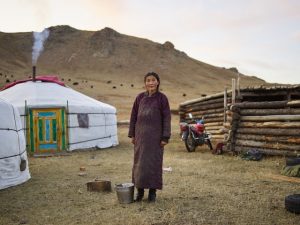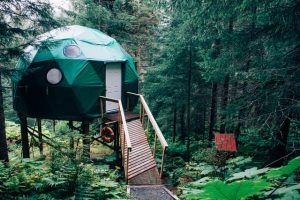Ecological housing with specific standards is developing more and more in industrialized countries. This need comes from the fact that the environment is strongly impacted in hyper-industrialized societies.
However, there are already homes that meet this need to respect nature. The yurt is obviously one of them.
So if a new human and ecological adventure tempt you, don’t hesitate to read this article to know everything about the yurt, how to build it, and how to live in a yurt all year round.
What is a yurt?
A yurt, originally, is the family dwelling of nomads living in Central Asia. The Mongols, for example, are a people for whom the yurt has a strong symbolism within the family and in daily life. It is passed on from father to son.
Originally, the yurt was conceived by these nomadic peoples to meet a simple need, that of moving with its dwelling. This one is easily assembled and dismantled. It answered perfectly to the request of the Mongolian people.
This family dwelling is in the shape of a dome, which is built with a wooden structure. Traditionally, it is covered with animal skins, but nowadays, different materials are used.
Contrary to appearances, the yurt is a well-insulated and pleasant habitat to live in. Moreover, its surface can vary according to the size of the family.
It is a dwelling that is becoming more popular because of its many ecological advantages. But, there are things you need to consider when setting up your yurt to live in.
The size:
Living in a yurt means, first of all living in a natural environment, living a lot outside…, enjoying the slightest ray of sunshine. We are in the front row; we must take this into account and not reason as if we were evaluating the surface of an apartment.
We advise yurts of 6m (28m²) for single people, which will guarantee a modest space but much easier to heat, transport, assemble, dismantle, maintain than larger yurts, especially if your project is to be nomadic.
For small families, we recommend yurts of 8m (50m²). Then, when the children grow up and the family expands, we recommend building new spaces that can be coupled with the “mother” yurt or placed nearby.
For the height of the walls, everything is possible from 1.8m, 2.0m, or 2.3m (for the installation of a mezzanine). Again, do not think too high. The height of 1.8m is sufficient for a comfortable living and interior design. This height makes the assembly less tiring and offers a reduced wind load.
The small dimensions of the Mongolian yurts (5.4 – 6.4m diameter, walls of 1.5-1.6m) are actually very well thought out. They are assembled without fatigue. The whole structure represents a modest weight, and the wind resistance is low. This allows nomads to keep their yurts until the end of their lives since even older adults can assemble, disassemble and transport them.
Insulation and heating:
For residential yurts, the quality of insulation should not be neglected to improve living comfort and limit the energy spent on heating. Therefore, we propose sheets of sheep wool of several thicknesses chosen according to the climate and the budget for the walls and the roof. In addition, we recommend having an insulated floor.
To heat the yurt, the wood stove is the best solution. To take advantage of the sun’s warmth, it is necessary to place a maximum number of glass openings to the south and east. A large transparent plastic window on the south side and insulating curtains for the night is a very effective and economical solution.
The ideal characteristics of a yurt stove are :
•A strong inertia to maintain heat at night. This translates into weight and quality cast iron. Earth bricks can be added on or around the stove.
•A small power to not be too hot and not make the stove work under the regime.
•A good performance: between 80 and 90% of output to consume less.
Water and electricity:
As far as the “extras” are concerned, water, electricity, dry toilets, the possibilities are varied. Experience shows that everyone has extremely diverse needs or desires, which also depend on the installation. Running water or not, electricity from the grid or solar, wind turbine. The solutions abound, the tricks are surprising…
Many take advantage of this great opportunity to learn about solar and wind energy, water filtration and purification systems, dry toilets, wood heating, gardening, etc. To say that the yurt opens the door to the future is not an empty word! It brings us to a more sober way of life. It would help if you did not hesitate to put it forward to make your installation accepted by your neighbors, local elected officials, etc…
Specifications for use and maintenance:
It is important to respect certain assembly rules, disassembly, and maintenance of your yurt to make it last and be safe. To do so, you need to have some training on the assembly guide describing the steps to follow and maintenance tips.
Main recommendations for installation and maintenance:
•The ground must be flat and level so that the yurt is stable and the frame does not twist. It must be perfectly stable to avoid sagging. The yurt must rest in a crawl space or out of water.
•The site must be sheltered from strong winds. In some cases of strong exposure, it will be necessary to erect a windproof fence. Also, you must be careful not to let the wind rush through the door or the crown. Finally, the ropes must be tightened in stormy weather if necessary; the poles must be fixed to the crown and screwed to the ground with metal brackets.
•The yurt should not be erected under trees. This will damage the waterproof canvas (sap, falling branches, etc.) and accelerate its deterioration.
•The yurt must be heated constantly during the wet days to avoid mold on the wood, the insulation, and the waterproof canvas. Therefore, it is essential to dismantle and store in a dry place the yurts that will not be heated during the wet periods (mainly autumn and winter).
•The yurt must be assembled according to the assembly guide provided. The rope or the compression cable must be fixed at the defined mark.
What are the Ecological Advantages of Living in a Yurt?
As you can imagine, from an environmental point of view, the yurt has only advantages.
Indeed, it uses few materials as opposed to a permanent home. It is therefore obvious that the energy spent for the “creation” of these materials is less. It is one of the most ecological dwellings available.
However, the ecological advantages of a yurt are not only hidden in its fabrication. Indeed, this style of housing is not energy consuming since its design aims to make good use of natural elements such as light, heat or wind. Thus, the environment allows the residents to live serenely. It is then up to you to arrange all around your yurt what is necessary to live well all year long: vegetable garden, rainwater collection, etc…
What are the regulations for building a yurt?
Several procedures are depending on the type of yurt you decide to build.
However, no formalities will be required from you if your yurt respects the following points:
•It is less than 35 m² on the ground.
•It has no sanitary facilities or kitchen.
•It is not connected to the collective network.
•It does not have foundations.
•It is removable and easily dismantled.
•It has no walls.
The yurt is then considered as a tent yurt. Be aware that it is a temporary installation (generally authorized for three months). Moreover, you must install it following the local urban plan. As a rule, where camping is allowed, so is the yurt tent.
However, if you want to make it your main home on your land, another regulation applies.
The PLU must authorize this type of construction in all the following cases, and your land must be buildable.
•For a yurt up to 50 m², a building permit is required with simplified formalities to comply with thermal regulations.
For a yurt larger than 50 m², a building permit and respect of the 2012 thermal regulations are required.
Nevertheless, you should contact the town hall of your location to find out exactly what steps to take.



